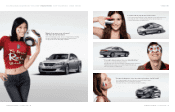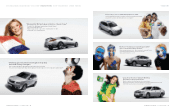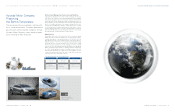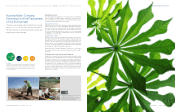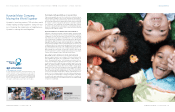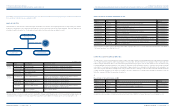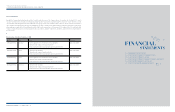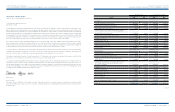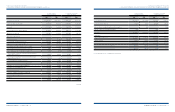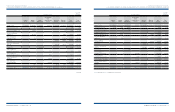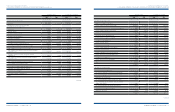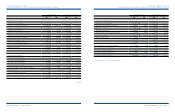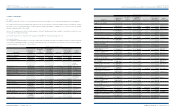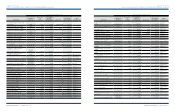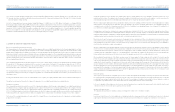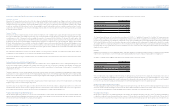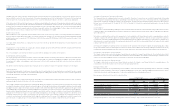Hyundai 2009 Annual Report Download - page 32
Download and view the complete annual report
Please find page 32 of the 2009 Hyundai annual report below. You can navigate through the pages in the report by either clicking on the pages listed below, or by using the keyword search tool below to find specific information within the annual report.
ASSETS 2009 2008 2009 2008
Current assets:
Cash and cash equivalents (Notes 3 and 10) ₩ 8,659,561 ₩ 6,218,218 $ 7,416,548 $ 5,325,641
Short-term financial instruments (Notes 3 and 10) 5,581,783 3,369,071 4,780,561 2,885,467
Short-term investment securities (Note 5) 252,602 1,065,429 216,343 912,495
Trade notes and accounts receivable, less allowance for doubtful
accounts and present value discount account of ₩195,463 million in 2009
and ₩247,539 million in 2008 (Note 16) 6,530,319 6,687,501 5,592,942 5,727,562
Trade notes and accounts receivable - other (Note 16) 779,469 975,218 667,582 835,233
Derivative assets (Note 29) 89,899 67,494 76,995 57,806
Deferred tax assets (Note 19) 1,082,180 1,163,042 926,841 996,096
Inventories (Notes 4, 10 and 24) 11,695,151 16,940,493 10,016,402 14,508,816
Advances and other current assets 2,115,413 2,287,922 1,811,762 1,959,507
Total current assets 36,786,377 38,774,388 31,505,976 33,208,623
Non-current assets:
Long-term financial instruments (Note 3) 76,238 12,571 65,295 10,767
Long-term investment securities (Notes 6 and 10) 756,238 1,075,254 647,686 920,910
Investment securities accounted for using the equity method
(Notes 7 and 16) 3,895,695 2,702,336 3,336,498 2,314,436
Property, plant and equipment, net of accumulated depreciation of
₩17,515,442 million in 2009 and ₩15,541,430 million in 2008
(Notes 8, 9, 10, 16 and 24) 28,821,237 28,918,261 24,684,170 24,767,267
Intangibles (Note 11) 3,708,187 3,448,857 3,175,905 2,953,800
Derivative assets (Note 29) 1,170,707 1,928,165 1,002,661 1,651,392
Deferred tax assets (Note 19) 420,641 689,650 360,261 590,656
Other assets (Note 12) 973,939 1,457,922 834,138 1,248,648
Total non-current assets 39,822,882 40,233,016 34,106,614 34,457,876
Other financial business assets (Notes 13 and 16) 25,715,675 24,198,379 22,024,387 20,724,888
Total assets ₩ 102,324,934 ₩ 103,205,783 $ 87,636,977 $ 88,391,387
(Continued)
INDEPENDENT AUDITORS’ REPORT
English Translation of a Report Originally Issued in Korean
To the Shareholders and Board of Directors of
Hyundai Motor Company:
We have audited the accompanying consolidated statements of financial position of Hyundai Motor Company (the “Company”) and its subsidiaries as of December 31, 2009
and 2008, and the related consolidated statements of income, changes in shareholders’ equity and cash flows for the years then ended, all expressed in Korean Won. These
financial statements are the responsibility of the Company’s management. Our responsibility is to express an opinion on these financial statements based on our audits. We
did not audit the financial statements of certain subsidiaries including Kia Motors Corporation, which statements reflect total assets of ₩48,617,024 million (US$41,638,424
thousand) and ₩51,272,235 million (US$43,912,500 thousand) as of December 31, 2009 and 2008, respectively, and total revenues of ₩52,837,394 million (US$45,252,992
thousand) and ₩44,079,949 million (US$37,752,611 thousand) in 2009 and 2008, respectively. Those statements were audited by other auditors whose reports have been
furnished to us, and our opinion, insofar as it relates to the amounts included for those entities, is based solely on the reports of other auditors.
We conducted our audits in accordance with auditing standards generally accepted in the Republic of Korea. Those standards require that we plan and perform the audit to
obtain reasonable assurance about whether the financial statements are free of material misstatement. An audit includes examining, on a test basis, evidence supporting
the amounts and disclosures in the financial statements. An audit also includes assessing the accounting standards used and significant estimates made by management,
as well as evaluating the overall financial statement presentation. We believe that our audits provide a reasonable basis for our opinion.
In our opinion, based on our audits and the reports of other auditors, the financial statements referred to above present fairly, in all material respects, the financial position
of Hyundai Motor Company and its subsidiaries as of December 31, 2009 and 2008, and the results of their operations, changes in its shareholders’ equity and their cash
flows for the years then ended, in conformity with accounting principles generally accepted in the Republic of Korea (See Note 2).
Our audits also comprehended the translation of Korean Won amounts into U.S. Dollar amounts and, in our opinion, such translation has been made in conformity with the
basis in Note 2. Such U.S. Dollar amounts are presented solely for the convenience of readers outside of Korea.
Accounting principles and auditing standards and their application in practice vary among countries. The accompanying financial statements are not intended to present the
financial position, results of operations, changes in shareholders’ equity and cash flows in accordance with accounting principles and practices generally accepted in coun-
tries other than the Republic of Korea. In addition, the procedures and practices utilized in the Republic of Korea to audit such financial statements may differ from those
generally accepted and applied in other countries. Accordingly, this report and the accompanying financial statements are for use by those knowledgeable about Korean
accounting procedures and auditing standards and their application in practice.
March 29, 2010
Notice to Readers
This report is effective as of March 29, 2010, the auditors’ report date. Certain subsequent events or circumstances may have occurred between the auditors’ report date
and the time the auditors’ report is read. Such events or circumstances could significantly affect the accompanying financial statements and may result in modifications to
the auditors’ report.
HYUNDAI MOTOR COMPANY AND SUBSIDIARIES
>>
CCONSOLIDATED FINANCIAL STATEMENTS FOR THE YEARS ENDED DECEMBER 31, 2009 AND 2008 AND INDEPENDENT AUDITORS’ REPORT
HYUNDAI MOTOR COMPANY AND SUBSIDIARIES
>>
CONSOLIDATED STATEMENTS OF FINANCIAL POSITION AS OF DECEMBER 31, 2009 AND 2008
Korean Won in millions U. S. Dollars (Note 2) in thousands
HYUNDAI MOTOR COMPANY I 2010 ANNUAL REPORT I 63HYUNDAI MOTOR COMPANY I 2010 ANNUAL REPORT I 62


